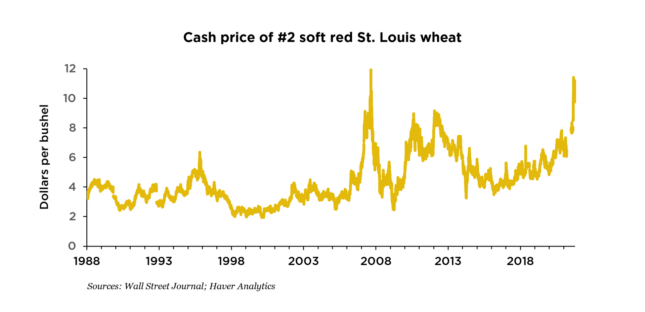Current readings show poor crop condition for winter wheat, driving prices even higher
Current readings show poor crop condition for winter wheat
Russia and Ukraine account for roughly one-third of global wheat exports. Consequently, Russia’s invasion of Ukraine sent wheat prices soaring and placed an even greater importance on this year’s U.S. wheat crop. Unfortunately, some states responsible for a significant amount of winter wheat acreage are being impacted by poor soil conditions due to long-standing droughts. The latest crop progress report offers a sobering look at the current winter wheat crop condition.

Ag News Highlights
No direct payments for fertilizer prices
Rising fertilizer prices are heavily impacting farm margins, but the USDA said in early April that there are currently no plans to provide direct payments to farmers to aid in purchasing fertilizer. According to a recent study from Texas A&M Agriculture and Food Policy Center (AFPC), nitrogen costs for farmers are up by 80 percent, or $52.07 per acre, from last year. In order to offset this cost increase, corn farmers would need an additional 32 cents per bushel either from the market or in direct payments from the government.
According to Jim Wiesemeyer of the DC Signal to Noise podcast, in lieu of direct payments the Biden administration is instead planning to ask railroads to accelerate the delivery of fertilizer supplies from the countryside to the corn belt, with a particular focus “on the eastern corn belt where they didn’t get as much fall fertilization done due to moisture.”
California snowpack far below normal levels
The California Department of Water Resources conducted their annual snowpack measurement at Phillips Station in late March and found only 2.5 inches of snow; the average snowpack in the area at the end of winter is five feet. On a statewide basis, snowpack is about 38 percent of normal levels. The California Nevada River Forest Center said this was the driest January-March on record for California, and it follows a year when intense drought conditions covered virtually the entire state. Snow melt is a vital source of water for the region, and with such low levels of snow Governor Gavin Newsom recently order local water suppliers to begin conservation plans.
Farmers very concerned about input costs
The Purdue University-CME Group Ag Economy Barometer fell by 12 points in March to 113, its lowest reading since May 2020 (when corn was $3/bushel, compared with more than $7/bushel today) and the fourth lowest since October 2016. The most prevalent concerns among farmers continue to be prices and availability of resources, and these concerns have only intensified due to Russia’s invasion of Ukraine. More than 90 percent of survey respondents believe input prices will rise by at least 20 percent in the next year, while 27 percent say have had trouble procuring crop inputs for the 2022 season.
Citations/Disclaimers
-
The information in this report is provided by Nationwide Economics and is general in nature and not intended as investment or economic advice, or a recommendation to buy or sell any security or adopt any investment strategy. Additionally, it does not take into account any specific investment objectives, tax and financial condition or particular needs of any specific person.
The economic and market forecasts reflect our opinion as of the date of this report and are subject to change without notice. These forecasts show a broad range of possible outcomes. Because they are subject to high levels of uncertainty, they will not reflect actual performance. We obtained certain information from sources deemed reliable, but we do not guarantee its accuracy, completeness or fairness.

